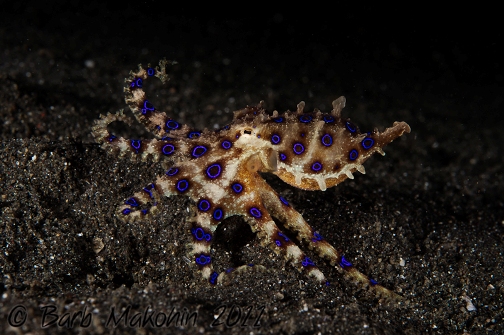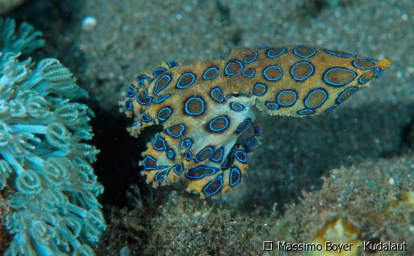Nutrition
Wondering what would you eat if you were a Hapalochlaena lunulata?
Cephalopods are carnivores by nature (Encyclopedia
of Life). The greater blue-ringed octopus are primarily found hunting during the day but
are occasionally found feeding at night (Blue
Ringed Octopus Facts). It feeds primarily on crabs,
mollusks, fish, and other tiny marine organisms (Animal
Diversity Web). The greater blue-ringed octopus is about
20 cm in length, but appears much smaller to the human
eye (Encyclopedia of Life). They hunt anything they are able to overpower due
to their small size. Hapalochlaena lunulata mainly lure
their prey by wriggling their arm like a worm, and it
also may swim by its prey, and pounce on it with a
surprise attack (Animal
Diversity Web). The H. lunulata either will
crack open its prey with it hard beak or it will break
the prey's body apart into pieces, and then with their muscular arms it will remove
any of the nutrient parts (Animal
Diversity Web). This species of octopus mainly
uses their skilled muscular tentacles,
and their venomous poison to hunt their prey.
octopus are primarily found hunting during the day but
are occasionally found feeding at night (Blue
Ringed Octopus Facts). It feeds primarily on crabs,
mollusks, fish, and other tiny marine organisms (Animal
Diversity Web). The greater blue-ringed octopus is about
20 cm in length, but appears much smaller to the human
eye (Encyclopedia of Life). They hunt anything they are able to overpower due
to their small size. Hapalochlaena lunulata mainly lure
their prey by wriggling their arm like a worm, and it
also may swim by its prey, and pounce on it with a
surprise attack (Animal
Diversity Web). The H. lunulata either will
crack open its prey with it hard beak or it will break
the prey's body apart into pieces, and then with their muscular arms it will remove
any of the nutrient parts (Animal
Diversity Web). This species of octopus mainly
uses their skilled muscular tentacles,
and their venomous poison to hunt their prey.
The Hapalochlaena lunulata is the most deadly octopus
species in its class. Their venom is so deadly, that one
single octopus contains enough venom to kill about 26
adult humans within minutes (MarineBio).
But luckily they rarely encounter humans, so the death
rate is low. It is recommended not to handle or touch
this species of octopus because its so deadly, and there
is no known antidote (Blue
Ringed Octopus Facts). So if you are a diver or
snorkeler, I suggest you admire the species from afar.
This
octopus species contains two types of venom that are
secreted from two different venom glands (MarineBio).
One of the venoms is used to hunt small organisms. The
second venom, Tetrodotoxin, is extremely toxic and is used for protection from predators (Blue
Ringed Octopus Facts). The venom is secreted from
their salvia gland after piercing a hole in the prey's
shell or exoskeleton with their hard beak (MarineBio).
Once the prey is paralyzed, they use their hard beak to
tear off and eat the fleshy soft parts of the animal. An
enzyme in its venomous salvia partially digests
the prey's flesh which allows the octopus to suck out
the remain, and leaves the shell behind (Aquarium
of the Pacific). The mechanism for poisoning their
victim is still under scientific research (MarineBio).
Also, there have been scientific reports that are still
under investigation that suggest that the species may
also have the ability to spray venom in the surrounding
water of its victim to paralyze it without having to use
its beak (Aquarium of the
Pacific).
It is recommended not to handle or touch
this species of octopus because its so deadly, and there
is no known antidote (Blue
Ringed Octopus Facts). So if you are a diver or
snorkeler, I suggest you admire the species from afar.
This
octopus species contains two types of venom that are
secreted from two different venom glands (MarineBio).
One of the venoms is used to hunt small organisms. The
second venom, Tetrodotoxin, is extremely toxic and is used for protection from predators (Blue
Ringed Octopus Facts). The venom is secreted from
their salvia gland after piercing a hole in the prey's
shell or exoskeleton with their hard beak (MarineBio).
Once the prey is paralyzed, they use their hard beak to
tear off and eat the fleshy soft parts of the animal. An
enzyme in its venomous salvia partially digests
the prey's flesh which allows the octopus to suck out
the remain, and leaves the shell behind (Aquarium
of the Pacific). The mechanism for poisoning their
victim is still under scientific research (MarineBio).
Also, there have been scientific reports that are still
under investigation that suggest that the species may
also have the ability to spray venom in the surrounding
water of its victim to paralyze it without having to use
its beak (Aquarium of the
Pacific).
To learn about the reproduction of this species, go to the next page.
